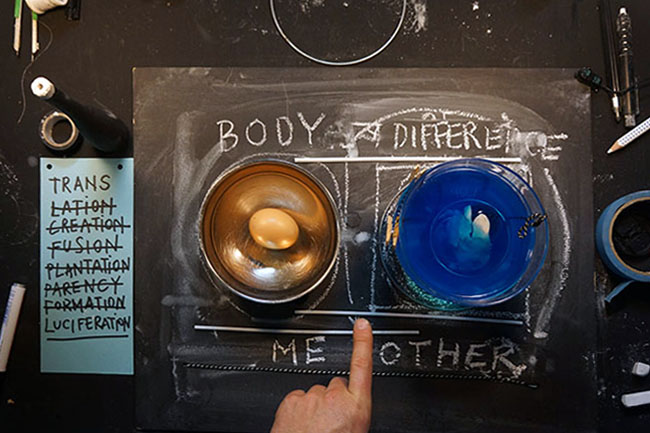Translecture on Transluciferation
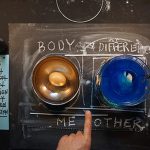
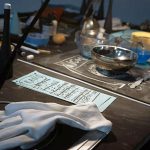
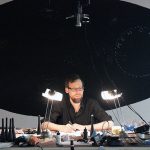
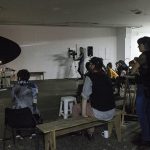
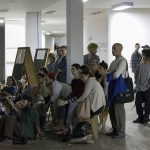
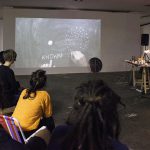
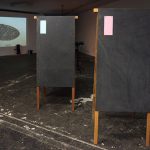

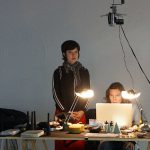
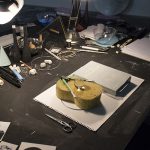
TRANSLECTURE ON TRANSLUCIFERATION
Based on the lecture text (below) by Brasilian curator and writer Daniela Castro on the dialectics of translation and the concept of transcreation by poet Haroldo de Campos, Nikolaus Gansterer developed together with Daniela Castro and the artist Paula Ordonhes – musically supported by Leandro Nerefuh and Caetano Carvalho – a live performance-lecture, which was staged as “Translecture on Transluciferation” at Artista Como exhibition at Pivo Gallery in Sao Paulo, Brazil, in May 2014.
que deus te guie porque eu não posso guiar
“que deus te guie porque eu não posso guiar” is the title of the text that shall remain untranslated. It is an excerpt of the book-poem Galáxias (1963-1976) by Haroldo de Campos. The poem has been translated into several languages, including English. The reason why I decided to keep it in Campos’s words is because I have appropriated it here to function as a title, a place where thoughts come to inhabit only to therein be dissolved, as Adorno would say. There is an oblique equivalent in this invitation of inhabiting the unknown for the reader who is not acquainted with Portuguese to how Campos begins speaking about the problems of translation, or, in Benjaminian terms, the task of the translator (Die Aufgabe des Übersetzers).
Translation is “Aufgabe”, he says, one of the oxymoronic words in German language that conveys at the same time the idea of giving, donating and relinquishing, abandoning. This abandonment relates to the communicational content that the translator renounces in order to re-give the form, freed from the task to simply (shallowly) transmit it. I imagine that for all its poetic weight, if I am to follow what Campos designated as transcreation in his radical theory of translation – to work with the physicality of the sign itself, its materiality, its sound properties, visual imagistics – I can only invite you to sense the feeling of renouncement that the verse in the title communicates. The reader should trust me that to abandon the knowledge of the place I have invited your thoughts to inhabit and be dissolved is experiencing what the verse signifies.
Inhabiting and dissolving into the unknown is traveling within the force of the spiral; no beginning, no end, no set direction. “Ideally, it begins in the Always, and Never is its term”, writes Osman Lins in “The Spiral and the Square”, one of the eight narratives of Avalovara (1973). But, god, we are not that strong. The square, the Cartesian form with precise spatial limits, both assists and ambushes the spiral. A site of rational redemption, perhaps. The original site. The spiral is the movement of translatability, its rhythmic tone, which reveals what the origin veils. The end of history, the crisis of language, the Western search for its significant Other (pun intended), the schizophrenic renewal of the novelty, the immaterial connection, and the rational organization of all that, makes us spin on wheels within the square, not to spiral. Ultimately, this text sees translation as transformation, transmutation, as fictional writing, as invention that is not known by its inventor, as relinquishing the square and meeting the spiral. By a force unknown to myself, the footnote to the present title made its way up here, for instance.
I remember going to an old and respectable homeopathic doctor. My father took me when I was a child. I already wore an orthopedic hand in those times. The doctor touched it to measure my pulse rate. I was so intimidated that I did nothing to spare him from the equivocation. The respectable doctor grabbed the plastic wrist tightly. After all, not at any moment did he find me dead. On the contrary, as he counted the supposed pulsations, he dictated out loud to his assistant the prescription that would cure me of all maladies. (From the Diary of the Nobel Prize of Physics, 1960. Mario Bellatin, Flores, São Paulo: Cosac & Naify, 2009. Translation Josely Vianna Baptista.)
Homeopathy is a type of medical treatment very common where I come from. It is not understood as an alternative medicine, no. In fact, it is usual to combine allopathic treatment with homeopathic drugs, should a patient desire so or should a doctor think that it would cause less harm in the holistic, albeit technological, make up of the human body.
Allopathic medicine aims objectively and mercilessly at the disease under attack: for instance, a transplantee may develop leukemia as a result of the treatment for a malfunctioning heart that had to be replaced by another’s heart. But that is so because it looks at the heart only, and not at the compass of the overall project that it pumps blood to. This “overall project” has a name. Life, and in Antonin Artaud´s words “There is nothing in fact more ignobly useless and superfluous than the organ called heart, which is the vilest means that one could have invented for pumping life into me.“ quoted in Jean-Luc Nancy, L’Intrus (1). Then, it looks at the leukemia only, keeping track of charts measuring the immune deficiency caused by the damned equivalent, the transplant, to the original quagmire that caused it, the malfunctioning heart. And so it goes, not as a harmonic tone, tuning, but as unwelcome interferences, noise.
Homeopathic interventions, on the contrary, infect the body with the very same disease that is under attack. Worsen it, strengthen the intruder that caused the malady – alas, a sin against the obscene lack of illness in today’s understanding of healthy living, which includes a whole program involving happiness, architecture, personal trainers and fancy billboards. That is so because the body can, at its last resource facing imminent death, revert the code, fracture the logic, create antibodies that in turn kill the virus, bacteria and otherwise, which has now become a broken link to the original disease. It takes longer, yes. The timeless time that is needed for the musicians to tune up their instruments just before the performance starts.
The translator-transcreator of aesthetic texts is the choreographer of the internal dance present in languages, says Haroldo de Campos. The content cannot be understood as a linear point-of-start-point-of-arrival, but as a semantic backstage or a multifold set design to this itinerant choreography. The transcreator must recognize the general design of the poetics of the original in order to re-design and re-disseminate it within the spatial setting of the translated text, understood now as an isomorphic re-project. This is what he terms the physics of translation, where the inbuilt charge of mimesis refers not to a theory of copy or reflection, but as a production of difference within the same. The transcreation procedure is, therefore, a radical operation of transfusion of blood and with a dental touch of irony, we could even speak in terms of vampirism, thinking now about the nourishment of the translator.”(2) “As soon as intrusion occurs, it multiplies, making itself known through its continually renewed internal differences”, says the transplantee-leukemia patient who, having another’s heart pumping blood into him, relinquishes the privilege of voicing the pronoun “I” without having to question its unity, its location and legitimacy. (3)
Campos postulated his theory in response to Benjamin’s metaphysical reasoning of translation. Benjamin disestablished and demystified the norm of transparency of the content, the dogma of fidelity and the servility of the traditional theory of translation. He promoted the estranging aspect of the operation of translation as transformation, the “transplant” of a form into another form, whereby the “pure language” that echoes from the original is to be liberated in the translated text. Campos notes, however, that he still insists on a categorical distinction between the original and translation. The original as sacred logos that is to be inhabited, sublimated even, by means of exteriority.
As a disobedience to the apparently natural dichotomy between form and content, the physics of translation calls for a more humane venture, which is released from the hieratic subservience of an “auratic” original. To the angelical image lent by the Benjaminian redemption (deliverance, liberation), Campos offers the idea of transluciferation, which is freed from the theological horizon of the “pure language.” It refuses to serve submissively to content; refuses the tyranny of a pre-ordained logos, and ruptures with the “metaphysical enclosure of presence, as Derrida would say”: translation becomes an enterprise of Satan, transgressive par excellence. The creative translation, possessed by demonisms, is neither pious nor memorial: it intends, at its limit, the erasure of the origin, the obliteration of the original; it aims even if for a fraction of a second to transform the original into the translation of its own translated version. Out of my prosthetic hand, a plastic wrist, you project my life by giving out what you believe to be the cure of all its maladies.
The original reveals itself susceptible to an implacable vivisection that whirls its innards only to be brought back to light in a diverse linguistic body. Jean-Luc Nancy’s “I” refers to a body where normally one would say categorically “me”, the original self, but that is assumed as often as it is shirked as being split, abandoned, deferred. “We are, along with all my more and more numerous counterparts, the beginnings of a mutation: man recommences going infinitely beyond man (that is what the ‘death of god’, in all its possible senses, has always meant).” The death of god gives rise to a supra-humane re-project that could be authorized only by the transgressive figure of Lucifer. Light.
The powerful implications of Campos’s proposition, inherited from the cultural modality of the Oswaldian anthropophagic reasoning, perhaps, is that it does not acknowledge the original as a parameter for its exterior other. It does not acknowledge the origin, period. As in an LP played backwards, transluciferation breaks with the ontological Western project by revealing that at its heart rests the “selfish burden of what it is to be ‘me’ and the black whole that is to be the ‘other’”. May god guide you, for I cannot guide.
Footnotes:
(1) “There is nothing in fact more ignobly useless and superfluous than the organ called heart, which is the vilest means that one could have invented for pumping life into me.“ Antonin Artaud, quoted in: Jean-Luc Nancy, L’Intrus, Michigan University Press: Édition Galilée, 2000, p. 1.
(2) “… and with a dental touch of irony, we could even speak in terms of vampirism, thinking now about the nourishment of the translator.” Haroldo de Campos, “Transluciferação Mefistofáustica”, in Deus e o Diabo no Fausto de Goethe, São Paulo: Perspectiva, 1981, p. 208. Translated by Daniela Castro.
(3) Jean-Luc Nancy, p. 9.
Exhibition: Artista Como – or How To Conduct the Ceremonies of the Pedagocial?, 20 – 22 May 2014
Venue: Pivo Gallery space, Sao Paulo, Brazil
Curated by Leandro Nerefuh (a.k.a. Libidiunga Cardoso) and Beto Shwafaty. (Metropol Projectos)
The project was supported by the BKA – Bundeskanzleramt Austria.
Exhibition website: http://artistacomo.info
Artista Como consists of public presentations promoting discussion on contemporary art practices that develop through theoretical, performative and relational experiments. The project brings together artists who use different discursive methods (lecture, roundtable, commentary and concert) as ways to expand the artistic activity.
With contributions by Leandro Nerefuh, Gaeoudij Parl, Ana Laura Lopez, Raimond Chaves, Keroøàcidu Suäväk, Nikolaus Gansterer, Ricardo Basbaum, Rafael Rg & Livia Piccolo, Pedro Marighella, Fabi Borges, Jorge Menna Barreto, Cristiano Lenhardt, Caetano Carvalho, Beto Shwafaty, Daniela Castro, Paula Ordonhes.
